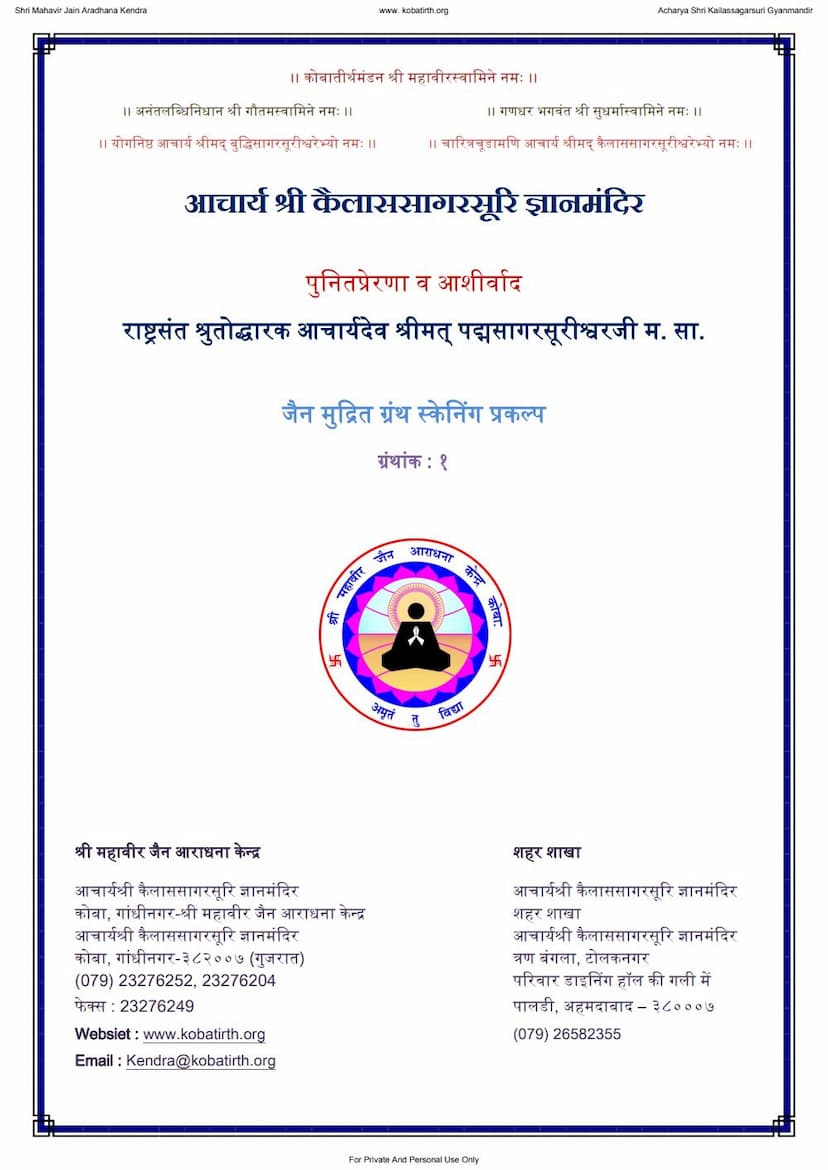Samvedasya Mantra Bramhnam
Added to library: September 2, 2025

Summary
Based on the provided text, here is a comprehensive summary of the Samavedasya Mantra Brahmanam by Satyabrata Samasrami:
Book Title: Samavedasya Mantra Brahmanam Author: Satyabrata Samasrami Publisher: Calcutta Publication Year: 1873 (as indicated by the date at the bottom of page 3)
Overall Content: This document is a scholarly work presenting the Mantra Brahmana portion of the Samaveda. It includes the original Sanskrit mantras, a commentary (likely in Sanskrit, referred to as "Bhasya Sahitam" on page 3), and a Bengali translation ("Vanganuvad Yukta" on page 3). The publication is a significant undertaking, aiming to make this Vedic text accessible through detailed explanation and translation.
Key Aspects and Structure:
- Vedic Text: The core of the work is the Mantra Brahmana of the Samaveda. This section of the Vedas typically deals with mantras and their ritualistic application, often in conjunction with sacrificial ceremonies.
- Commentary (Bhasya): The presence of a commentary indicates an effort to interpret the mantras, explain their meanings, and possibly their ritualistic significance. The commentary appears to be in Sanskrit, judging by the citations and explanations within the provided pages (e.g., the explanations of individual Sanskrit words and their meanings).
- Bengali Translation: The inclusion of a Bengali translation is a crucial element, suggesting the author's intent to reach a wider audience, particularly those in Bengal, who would be more familiar with Bengali. The translation is presented alongside the Sanskrit text and commentary, facilitating a deeper understanding.
- Scholarly Approach: The dedication to providing both commentary and translation, along with the evident effort in explaining each mantra (as seen in the detailed breakdown of words on pages 5-14), points to a rigorous scholarly approach.
- Structure of the Text (based on provided pages):
- Page 1-4: These pages likely contain title pages, acknowledgments, introductory remarks, publisher information, and perhaps a list of other published works by the author or publisher. The "Catalog link" provided in the prompt also indicates a listing within a Jain context, though the text itself is Vedic. Page 4 lists numerous Sanskrit literary works, suggesting the publisher or a related entity's extensive catalog.
- Page 5 onwards: This is where the actual Mantra Brahmana text begins, starting with "Mantra Brahmanam" and then proceeding with "Ath prathamaḥ prapathakaḥ" (First Chapter/Section of the First Adhyaya) and "Prathama Khandah" (First Part of the First Section).
- Verse-by-Verse Explanation: The subsequent pages (5-143) show a clear structure of presenting mantras (e.g., "Om. Deva Savitah prasuvayajñam..." on page 5) followed by detailed explanations and translations of those mantras. Each mantra is likely accompanied by its relevant ritualistic context or purpose.
- Metrical and Deity Information: Some verses include notations about the meter (chandah) and the presiding deity (devata) associated with the mantra (e.g., page 5 notes "Prajapatiḥ rṣiḥ. Yajuh. Savitā devatā."). This further emphasizes the academic and ritualistic nature of the work.
- Chapters and Sections: The text appears to be organized into Prapathakas (chapters or sections) and then further divided into Khandas (parts). For instance, the provided text covers parts of the first Prapathaka and goes up to the eighth Khanda, and then begins the second Prapathaka.
Content Focus (Illustrative Examples from provided pages):
The provided pages cover various mantras, often related to:
- Invocation and Blessings: Mantras invoking deities like Savitr, Agni, Vayu, Chandra, Surya, Vishnu, Indra, etc., for blessings, protection, prosperity, and well-being of individuals and the community.
- Life Cycle Rituals: There are indications of mantras used in significant life events, such as marriage ceremonies (e.g., page 8 onwards discussing a kanya and her rituals, hand-holding, and blessings for progeny) and naming ceremonies (e.g., pages 32-37, invoking deities for a child's name and long life).
- Worship and Offerings: Mantras related to making offerings (homa), invoking the assistance of deities in ritualistic actions, and seeking divine favor.
- Purification and Removal of Negativity: Mantras aimed at removing sins, ailments, and any form of negativity from individuals or surroundings (e.g., pages 25-28, where Agni is invoked to "shamyamyaham" - pacify or remove, sins from various parts of the body).
- Prosperity and Longevity: Many mantras focus on seeking blessings for wealth, progeny, cattle, and long life.
- Protection and Welfare: Seeking protection from enemies, dangers, and ensuring general welfare for the family and community.
- Ritualistic Elements: Mention of "Vratha" (vow or ritual), "Upadesha" (teaching or instruction), and "Soma" (a Vedic deity and ritualistic substance) suggests the detailed application of these mantras in specific religious observances.
Author and Publisher:
- Author: Satyabrata Samasrami is the author, indicating a scholar from that era.
- Publisher: The publisher is based in Calcutta (now Kolkata). The "Dweepayana Press" is mentioned as the printing press on page 3. The work seems to be available from "College of Calcutta" and "Pandit Jibananda Vidyasagara B.A. Sanskrit." This suggests it was published through academic or scholarly channels in Bengal.
Significance: This book is a critical resource for understanding the Mantra Brahmana of the Samaveda, especially for Bengali speakers. It preserves and disseminates ancient Vedic knowledge with detailed explanations, contributing to the study of Vedic rituals, philosophy, and linguistics. The Jain Education International catalog link provided in the prompt is interesting, as the text itself is Vedic, not Jain. This might indicate a broader catalog that includes Vedic texts alongside Jain literature, or a specific Jain institution's interest in comparative religious or linguistic studies.
In essence, Satyabrata Samasrami's Samavedasya Mantra Brahmanam is a foundational work that provides a scholarly bridge between the ancient Vedic tradition and the modern reader, especially through its commentary and Bengali translation.